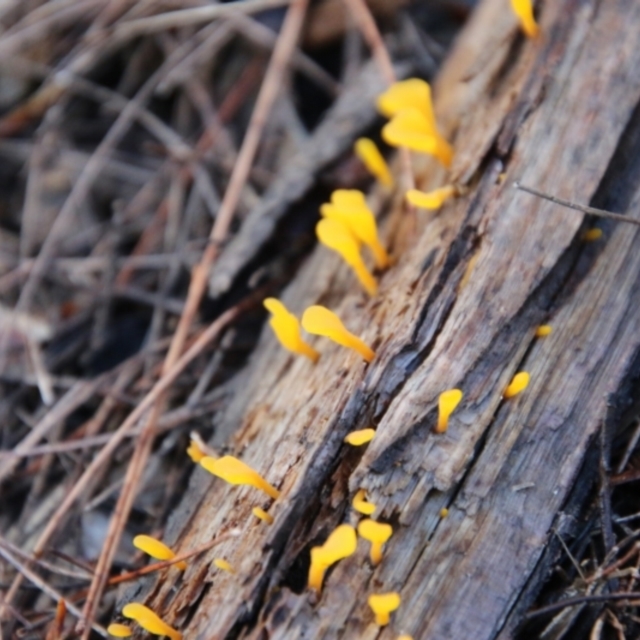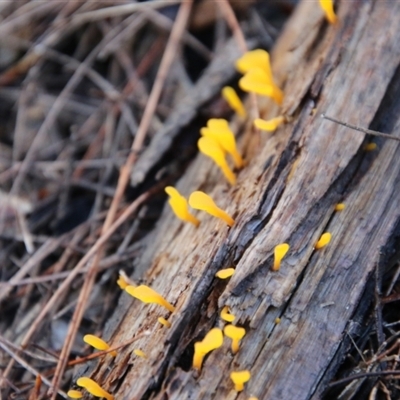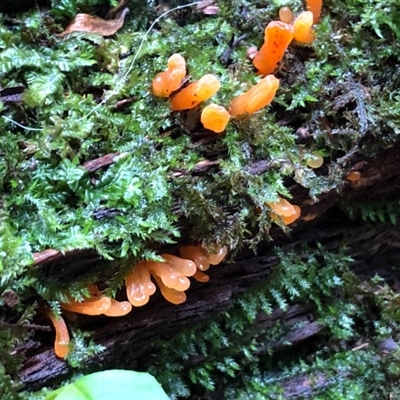Calocera sp.
Calocera sp. (A stagshorn fungus)
<p style="margin: 0cm 0cm 0pt; line-height: normal;"> </p>
<p> </p>
<p style="margin: 0cm 0cm 0pt; line-height: normal;"><span style="font-family: 'Georgia',serif;"><span style="font-size: medium;"><span style="color: #000000;">The fruit body is a stem, and often no more than that, but forking at the apex or slightly branched in some species. The fruit body has a fleshy to rubbery texture and is usually yellow to orange, though sometimes paler and close to buff. In most species the fruit bodies are no more than 3 centimetres tall (and often less than 1 centimetre) but those of <em style="mso-bidi-font-style: normal;">Calocera viscosa</em></span></span><span style="color: #000000; font-size: medium;"> may grow to over 10 centimetres and show more branching. </span></span></p>
<p> </p>
<p style="margin: 0cm 0cm 0pt; line-height: normal;"><span style="font-family: 'Georgia',serif;"><span style="color: #000000; font-size: medium;">The fruit bodies appear on dead wood (of native or introduced trees) in a wide variety of habitats. Usually numerous fruit bodies appear simultaneously.</span></span></p>
<p> </p>
<p style="margin: 0cm 0cm 0pt; line-height: normal;"><span style="font-family: 'Georgia',serif;"><span style="color: #000000; font-size: medium;">Identification of species usually relies on microscopic features.</span></span></p>
<p> </p>
<p style="margin: 0cm 0cm 0pt; line-height: normal;"><strong style="mso-bidi-font-weight: normal;"><span style="font-family: 'Georgia',serif;"><span style="color: #000000; font-size: medium;">Look-alikes</span></span></strong></p>
<p> </p>
<p style="margin: 0cm 0cm 0pt; line-height: normal;"><span style="font-family: 'Georgia',serif;"><span style="font-size: medium;"><span style="color: #000000;">Some of the unbranched or slightly branched coral fungi (in the genera <em style="mso-bidi-font-style: normal;">Clavaria</em></span></span><span style="color: #000000; font-size: medium;">, </span><em style="mso-bidi-font-style: normal;"><span style="color: #000000; font-size: medium;">Clavulinopsis</span></em><span style="color: #000000; font-size: medium;">, </span><em style="mso-bidi-font-style: normal;"><span style="color: #000000; font-size: medium;">Ramaria</span></em><span style="color: #000000; font-size: medium;"> or </span><em style="mso-bidi-font-style: normal;"><span style="color: #000000; font-size: medium;">Ramariopsis</span></em><span style="color: #000000; font-size: medium;">) have yellow fruit bodies and may be no more than a few centimetres tall. However, they grow mostly on soil, but a few species may appear on well-rotted wood. By contrast species of </span><em style="mso-bidi-font-style: normal;"><span style="color: #000000; font-size: medium;">Calocera</span></em><span style="color: #000000; font-size: medium;"> are found only on wood and usually on wood still far from rotted, albeit possibly covered by litter, mosses or the like so you may need to check carefully to be sure of the substrate.</span></span></p>
<p> </p>
<p style="margin: 0cm 0cm 0pt; line-height: normal;"><span style="font-family: 'Georgia',serif;"><span style="mso-spacerun: yes;"><span style="color: #000000; font-size: medium;"> </span></span><span style="color: #000000; font-size: medium;">Many </span><em style="mso-bidi-font-style: normal;"><span style="color: #000000; font-size: medium;">Dacryopinax</span></em><span style="color: #000000; font-size: medium;"> fruit bodies are yellow to orange, 1-2 centimetres tall and found on fairly firm wood. The fruit body consists of a short stem with a markedly broadened apex, from spatula-like to cup-like, sometimes lobed. Some species of </span><em style="mso-bidi-font-style: normal;"><span style="color: #000000; font-size: medium;">Calocera</span></em><span style="color: #000000; font-size: medium;"> may have slightly broadened apices and </span><em style="mso-bidi-font-style: normal;"><span style="color: #000000; font-size: medium;">Dacryopinax</span></em><span style="color: #000000; font-size: medium;"> is a genus that, on macroscopic features, could sometimes be confused with </span><em style="mso-bidi-font-style: normal;"><span style="color: #000000; font-size: medium;">Calocera</span></em><span style="color: #000000; font-size: medium;">, especially when fruit bodies are immature. Since the fruit bodies of both genera usually appear in large groups, it may pay to look at the variation within the group, which is likely to include both immature and mature specimens, before making a decision. </span><span style="mso-spacerun: yes;"><span style="color: #000000; font-size: medium;"> </span></span></span></p>
<p> </p>
Calocera sp. is listed in the following regions:
Canberra & Southern Tablelands | South Coast
Species information
- Calocera sp. Scientific name
- A stagshorn fungus Common name
- Not Sensitive
- Local native
- Non-invasive or negligible
- Up to 1335m Recorded at altitude
- Machine learning












